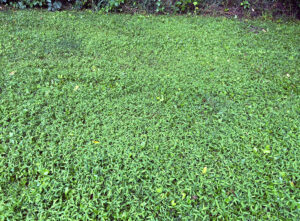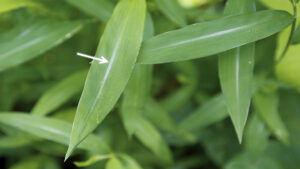
A mat of Japanese stiltgrass growing in Rock County, Wisconsin, in July 2025. / Photo Credit: John Zaborsky, University of Wisconsin-Madison Renz Weed Science Lab
By Wisconsin DNR
The harmful invasive plant Japanese stiltgrass (Microstegium vimineum) has been detected in a private woodland near Beloit in Rock County, according to a blog post made Monday by the University of Wisconsin-Madison Extension.
It is the second detection of the non-native annual grass in Wisconsin. The first took place in 2020, inside the Coulee Experimental Forest in La Crosse County. The Wisconsin Department of Natural Resources (DNR) has been working to eradicate that population.
Japanese stiltgrass poses a significant threat to Wisconsin’s ecosystems. It grows in branching, sprawling mats in forests, streams, trails, ditches and lawns. In the eastern and southern United States, including Illinois, it is widespread and has been negatively impacting forests.

A close-up photo of Japanese stiltgrass leaves, showing their characteristic white vein markings. / Photo Cradit: John Zaborsky, University of Wisconsin-Madison Renz Weed Science Lab
While a survey surrounding the site of the Rock County discovery uncovered no additional infestations on adjacent landowners’ properties, UW-Madison Extension has issued a call to action, asking for help from southern Wisconsin residents.
Residents of southern Wisconsin counties – particularly Grant, Green, Kenosha, Lafayette, Rock and Walworth counties – are asked to search nearby neighborhoods and woodlands for Japanese stiltgrass.
If you believe to have found this invasive plant, it should be immediately reported to one or both of the following email addresses:
- UW-Madison Extension’s Forestry team: Forestry@extension.wisc.edu
- The DNR Invasive Species team: Invasive.Species@wisconsin.gov
Reports should include:
- Close-up photos of the grass, along with mid-range and wide-angle photos that show the landscape.
- The exact location of the infestation, along with the plants’ size, habitat and density.
The UW-Madison Extension blog post contains extensive facts on Japanese stiltgrass, tips on accurate identification (including an instructional video and multiple photos) and possible actions to take if the plant is verified in a new location.
“This plant is quite harmful to our forests,” said Mark Renz, a professor and UW-Madison Extension weed specialist. “It makes wildfires more frequent and severe, alters nutrient cycling and soil microbes, and reduces wildlife habitat, all of which decreases biodiversity.”
